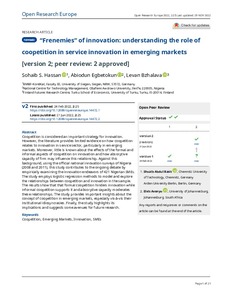'Frenemies' of innovation: Understanding the role of coopetition in service innovation in emerging markets
Hassan Sohaib S.; Egbetokun Abiodun; Bzhalava Levan
https://urn.fi/URN:NBN:fi-fe202301183415
Tiivistelmä
Coopetition is considered an important strategy for innovation. However, the literature provides limited evidence on how coopetition relates to innovation in service sector, particularly in emerging markets. Moreover, little is known about the effects of the formal and informal aspects of coopetition on innovation and how absorptive capacity of firm may influence this relationship. Against this background, using the official national innovation surveys of Nigeria (2008 and 2011), this study contributes to the ongoing debate by empirically examining the innovation endeavors of 421 Nigerian SMEs. The study employs logistic regression methods to model and explore the relationships between coopetition and innovation in the sample. The results show that that formal coopetition hinders innovation while informal coopetition supports it and absorptive capacity moderates these relationships. The study provides important insights about the concept of coopetition in emerging markets, especially vis-à-vis their institutional idiosyncrasies. Finally, the study highlights its implications and suggests some avenues for future research.
Kokoelmat
- Rinnakkaistallenteet [27094]
